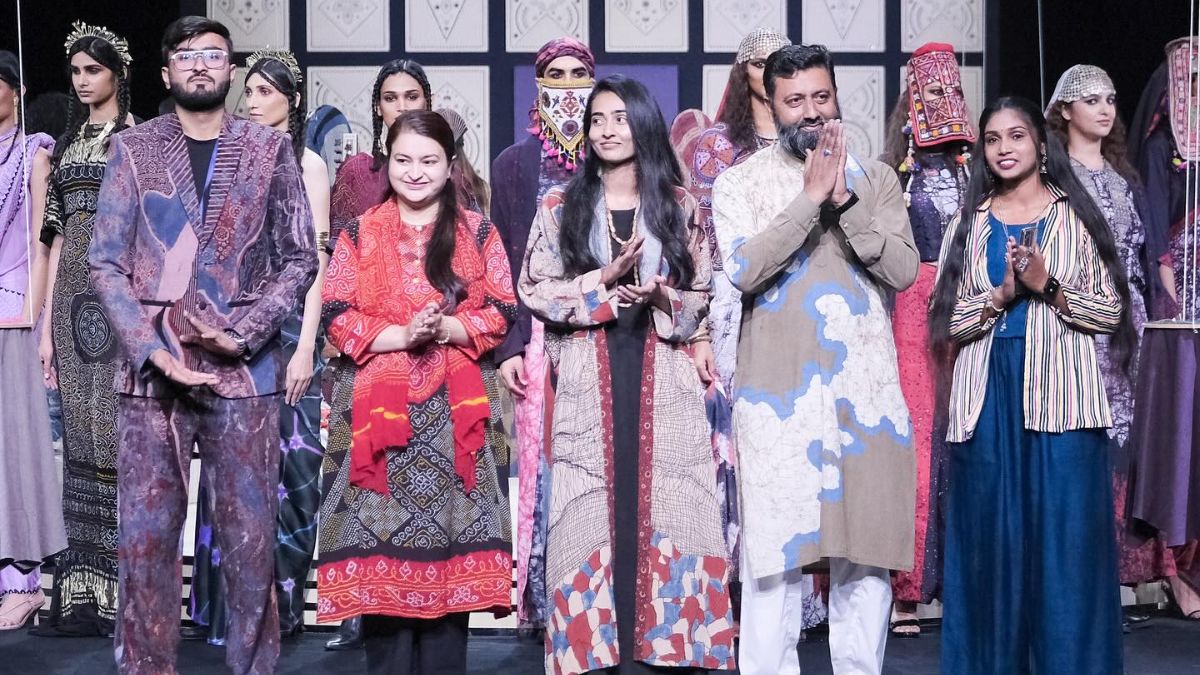Lakme Fashion Week X FDCI: When children of Kutch artisans put together a brilliant fashion show
 Artisan designers of Somaiya Kala Vidya: Ajrakh Gharana by Zaid Khatri, Alaicha by Amruta Vankar, Elysian by Mubbasirah Khatri, Musk by Muskan Khatri, Neel Batik by Shakil Ahmed at Lakmē Fashion Week in partnership with FDCI | via Instagram
Artisan designers of Somaiya Kala Vidya: Ajrakh Gharana by Zaid Khatri, Alaicha by Amruta Vankar, Elysian by Mubbasirah Khatri, Musk by Muskan Khatri, Neel Batik by Shakil Ahmed at Lakmē Fashion Week in partnership with FDCI | via Instagram
It is indeed rare to see a fashion show these days where half the room is standing in ovation. But so moved was the audience – a very stylish one at that – by the show put together by students of Somaiya Kala Vidya institution in Kutch, at the Lakme Fashion Week in partnership with FDCI, even stalwarts like designer James Ferreira, model Binal Trivedi and architect Anca Abraham were left misty-eyed.
Contemporary styles of clothing – pant-suits, dresses, kaftans, drapes, modern blouses and jackets – were presented in some antique hand dyeing and printing techniques from the Kutch belt in Gujarat. The Kutch crescent, that stretches from Gujarat to Rajasthan, remains the most craft-rich belt in India. The crafts shown here were batik, ajrakh and bandhini.
The young designers, most of whom are in their early 20s, and some have studied formally just till grade 10 or high school, have spent one year studying fashion at the Somaiya Kala Vidya school in Kutch. Amrita Somaiya, who helms the school, has also started an initiative called Design Craft where the students are taught business and marketing skills.
Shakil Ahmed Khatri, who lives 50km from Bhuj in a village called Mundra, is among the oldest alumni. At 43, he attended Kala Vidya in 2009, when it was called Kala Raksha. He is a sixth generation batik artisan. Batik is an ancient art of resist dyeing using wax. “The course is of six semesters, and they teach us the basic of colour, design marketing, presentation and even how to create a logo,” he says. “When I joined I was limited in my approach. A tree for me was just a tree, but I learned to look at things in a new way.”
Shakil’s batik work was of extraordinary patterns on cloth. “Compared to ajrakh and bandhini, batik is a forgotten art of Kutch, and I needed to promote it. I started painting on batik and began to work with newer colours and layouts,” he adds. Shakil sells in some small stores in Ahmedabad and Delhi, and on an online platform called Itokri.
The youngest here is M Zaid Khatri. At 2021, he is a new graduate. Zaid hails from Ajrakhpur and has studied only till the tenth grade. “I knew nothing but I learned everything,” he says. I am alarmed to see how sophisticated his denim pant suits are, all printed in beautifully derivatives of the colours of ajrakh, a geometric style of block printing using especially black, red, white and blue. “I learned how to develop a concept. Especially how to play with the colours of ajrakh so they are different but still look like they are from the same family.”
Zaid says he is thrilled with the fashion show. “Our hard work was so well presented. I am filled with joy.”
Mubassirah Khalid Khatri is 25, and is one of two women in Kutch who works in ajrakh, as most textile and weaving art forms in India are dominated by men. “My father, who is also an artisan in Ajrakhpur, was very supportive. He gave me a large table at home to work from,” she says. Mubassirah sells on Instagram under @elysians_ajrakh.
Muskan Khatri, 25, is from Bhuj and is a graduate of the 2018 batch, says she only worked in traditional bandhini styles before, using colours like red, yellow and white. “Now I have started using neon colours. When people see neon colours on black, they know it is from Muskan’s collection,” she smiles proudly. “I get my nani (maternal grandmother) and dadi (paternal grandmother) to help me with the knots too. Bandhini is a tie-dye technique where the cloth is pinched and tied in tiny dots that resist the dye, resulting in small white circles.
Muskan is wearing real gold kurta buttons with her crepe bandhini kurta today. “My father started the bandhini business for us, before that he used to run a bakery but we found more success in textile,” she says. Muskan says she already sells off Instagram (@musk_bandhani) and is looking for more online sales.
Vankar Amruta Babubhai is a 23-year-old from Bhujodi. “My father used to make Rabari turbans, then he started working in mashru,” she says of the thick cotton and silk mix. “During our vacations, we would all sit on the loom weaving. He made me start on Mashru when I was 14,” she says.
Amruta’s label is called Alaichi. “Kala Vidya taught me how to weave mashru in 50 inches, before that I could only weave 20 inches. I learned to work in silk, dyeing and in ikat too. I also learned about the language and the jargon of design,” says Amruta who is also selling on Instagram (@ab_mashru_weavers).
Amriya Somaiya says the girls’ families have been amazing in encouraging their ambitions. Kutch is far more progressive than the northern states are. The girls today were not fasting for Ramadan either, even though the two male designers were.
Lifestyle